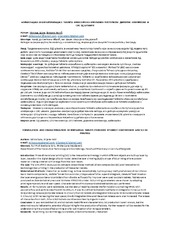Приказ основних података о документу
Формулација и карактеризација таблета ирбесартана израђених поступком директне компресије и СЛС 3Д штампе
Formulation and characterization of irbesartan tablets produced by direct compression and SLS 3D printing
| dc.contributor | Ibrić, Svetlana | |
| dc.contributor | Madžarević, Marijana | |
| dc.creator | Šuka, Milica | |
| dc.creator | Kelić, Biljana | |
| dc.date.accessioned | 2021-05-20T10:20:40Z | |
| dc.date.available | 2021-05-20T10:20:40Z | |
| dc.date.issued | 2021 | |
| dc.identifier.uri | https://farfar.pharmacy.bg.ac.rs/handle/123456789/3849 | |
| dc.description.abstract | Увод: Тродимензионална (3Д) штампа је иновативна технологија помоћу које се на основу задатог 3Д модела могу добити различити производи штампањем слој по слој. Селективно ласерско синтеровања (СЛС) је врста 3Д штампе која се заснива на процесу синтеровања честица прашка под дејством ласерског зрака. Циљ рада: Циљ рада представља поређење конвенционалне методе–директне компресије и иновативне 3Д технологије–СЛС штампе у изради таблета ирбесартана. Материјал и методе: За добијање таблета коришћени су ирбесартан као модел лековита супстанца, лактоза монохидрат, хидрокспропилметил целулоза, ХПМЦ (Vivapharm® E3) и манитол (Parteck®M 200) као основне компоненте матрикса, Kollidon®VA 64 Fine као везивно средство, Crospovidone®NF као супердезинтегратор, Candurin®Gold Sheen као средство за побољшање апсорпције енергије ласера и колоидни силицијум диоксид (Aerosil® 200) као средство за побољшање проточности. Таблете су израђенена лабораторијском симулатору компакције Gamlen таблет машини и СЛС 3Д штампачу Sintratec Kit. Параметри СЛС штампе су одређивани подешавањем темпрературе и брзине ласера. Извршена је карактеризација смеша и добијених таблета. Резултати: Све формулације су биле таблетабилне, а најбољу принтабилност су показале формулације које су садржале ХПМЦ као компоненту матрикса, имале прихватљиву проточност и највећи удео честица величине од 63 до 180 µm. Уочено је да се СЛС таблете брже распадају (време распадања до 25 мин) и брже ослобађају ирбесартан (комплетно ослобађање до 2 сата) од конвенциналних таблета (време распадања до 39 мин и комплетно ослобађање до 3 сата). Са повећањем брзине ласера повећавала се и распадљивост таблета и брзина ослобађања ирбесартана. Higuchi-јев модел је најбоље описао кинетику ослобађања ирбесартана из таблета израђених и конвенционалном и СЛС методом. Закључак: Уочене су значајне разлике у карактеристикама таблета ирбесартана израђених поступком директне компресије и СЛС штампе. Директна компресија је добро позната метода, али добијени резулати указују на потенцијал СЛС штампе у изради таблета. Како би се у потпуности разумела иновативна СЛС штампа и извршила оптимизација процесних параметара потребна су детаљнија истраживања. | sr |
| dc.description.abstract | Introduction: Three-dimensional printing (3D) is the innovative technology in which different objects are built up layer by layer, based on the digital design of a 3D model. Selective laser sintering (SLS) is a type of 3D printing where powder material is being sintered with energy from the laser beam. The Aim: The aim of this study was to compare conventional method–direct compression (DC) and innovative 3D technology– SLS printing in the production of irbesartan tablets. Material and Methods: Irbesartan as model drug, lactose monohydrate, hydroxypropyl methylcellulose and mannitol as basic matrix components, Kollidon®VA 64 Fine as binder, Crospovidone®NF as superdisintegrant, Candurin®Gold Sheen as the laser energy absorber and colloidal silicon dioxide as flowability improver were used to obtain tablets. Tablets were produced on Gamlen tablet press and Sintratec Kit SLS 3D printer. SLS printing parameters were chosen by adapting printing temperature and laser speed. Characterization of mixtures and obtained tablets was performed. Results: All formulations were tabletable, but the best printability showed the formulations containing HPMC with passable flow and particle sizes from 63 to 180 μm. It was found that SLS tablets had faster disintegration time (up to 25 min) and drug release (complete release in 2 hours) than DC tablets (disintegration time up to 39 min and complete release in 3 hours). With increasing the laser speed, the disintegration time and irbesartan release were also increased. The release of irbesartan from both, DC and SLS tablets could be described by Higuchi model. Conclusion: It was noticed that DC and SLS tablets had different characteristics. DC production is well-known, but the obtained results indicate the potential of SLS printing for the production of tablets. Further research will be needed for the understanding the process of SLS printing and for optimization of printing parameters. | sr |
| dc.language.iso | sr | sr |
| dc.language.iso | en | sr |
| dc.rights | openAccess | sr |
| dc.rights.uri | https://creativecommons.org/licenses/by/4.0/ | |
| dc.subject | 3D printing | sr |
| dc.subject | SLS technology | sr |
| dc.subject | SLS tablets | sr |
| dc.subject | direct compression | sr |
| dc.subject | irbesartan | sr |
| dc.title | Формулација и карактеризација таблета ирбесартана израђених поступком директне компресије и СЛС 3Д штампе | sr |
| dc.title | Formulation and characterization of irbesartan tablets produced by direct compression and SLS 3D printing | sr |
| dc.type | conferenceObject | sr |
| dc.rights.license | BY | sr |
| dcterms.abstract | Келић, Биљана; Шука, Милица; Formulacija i karakterizacija tableta irbesartana izrađenih postupkom direktne kompresije i SLS 3D štampe; | |
| dc.identifier.fulltext | https://farfar.pharmacy.bg.ac.rs/bitstream/id/8804/bitstream_8804.pdf | |
| dc.identifier.rcub | https://hdl.handle.net/21.15107/rcub_farfar_3849 | |
| dc.type.version | publishedVersion | sr |

